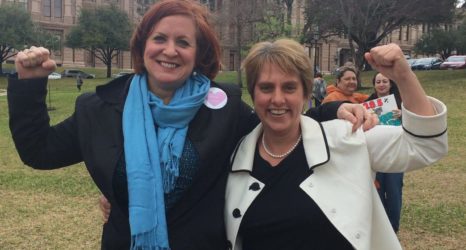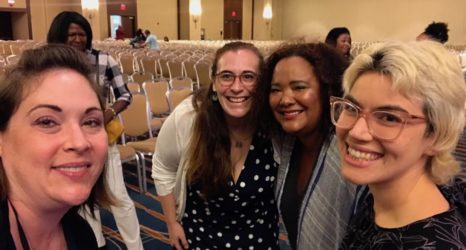
The theme of the 2019 National Sexual Assault Conference—Beyond the Breakthrough—sought to inspire the collective movement to end sexual violence and build on the momentum of the #MeToo movement. Ms. was the media sponsor for the conference—and expanded the discussions happening on-site with this dedicated series. Click here to read more posts. You can also watch interviews and conference sessions from #NSAC2019 on the Ms. Facebook!
The #MeToo movement facilitated a national conversation about personal accountability and instigated a conversation about what it means for institutions, organizations and communities to actively address the culture they promote. The ongoing discussion introduced by #MeToo speaks to making sexual violence prevention concrete—from the military to workplaces to schools.
RALIANCE is excited to join many of our impact grantees at this year’s 2019 National Sexual Assault Conference (NSAC), which is focused on cementing the progress made by the #MeToo movement—and taking it even further. One of our former grantees, the Moore Center for the Prevention of Child Sexual Abuse at Johns Hopkins Bloomberg School of Public Health, does work that has been instrumental in looking at how we intervene before harm occurs and offer support to change behavior, especially among young people.
Amanda Ruzicka, Director of Research Operations at the Center, sat down with RALIANCE to discuss her NSAC workshop on a new prevention intervention aimed at providing middle school students and their caregivers with knowledge, skills and tools to avoid sexual behavior with younger children.

We know prevention is possible and happening—but what does prevention look like?
Prevention can take on multiple forms. At the Moore Center, we are working to prevent child sexual abuse in a groundbreaking way—by targeting perpetration prevention with adolescents. Research has shown that adolescents commit up to half of all child sexual abuse incidents against younger children, and that the onset of this behavior peaks at age 14. We also know that most times adolescents engage in harmful sexual behaviors with younger children because of factors like the absence of adult supervision, or a lack of knowledge about appropriate sexual behaviors and how their actions can impact themselves and others—not because they are bad kids.
Our Responsible Behavior with Younger Children (RBYC) program aims to provide sixth and seventh grade students with the knowledge, tools and skills they need to model healthy behaviors with younger children and their peers. RBYC focuses on what behaviors are harmful and constitute sexual harassment or child sexual abuse, the consequences of those behaviors, as well as why these behaviors are harmful and how to prevent them. Students learn about real-life scenarios when harmful sexual behaviors could take place, how to take the perspective of a younger child and how respond in a healthy and empathetic way. Other sessions highlight the developmental differences between adolescents and younger children, healthy behaviors with younger children and peers and how to be a good bystander or upstander.
We just finished implementing the program, so we don’t yet know what type of impact it had. However, some of the students wrote our team thank-you notes after we implemented the RBYC program in their classroom, and several students shared that they weren’t excited about the program when their teacher told them about it—but after the first few sessions they not only learned a lot, but were really enjoying the program!
What can schools do to help prevent child sexual abuse?
One of the best things schools can do to help prevent child sexual abuse is to talk about it. Throughout the development and initial testing of our RBYC program, we held focus groups with students, parents and educators to obtain feedback on the program sessions and to address any of their concerns about how to implement the program within middle school classrooms.
Everyone we talked to, even the students, said it was important to teach sixth and seventh graders about child sexual abuse, but many were afraid to engage in these discussions. Some educators were concerned they didn’t have all the tools they needed to address student questions, comments and especially disclosures of abuse or inappropriate sexual behaviors students engaged in.
In our RBYC program, one of the ways we address these concerns is to provide students with a resource sheet providing resources within their schools, communities and beyond. We teach students about safe adults they may know who they can talk to, as well as those they can contact on a 24-hour hotline if they would like to remain anonymous. In addition, our team works closely with the mental health professionals and administrators in the schools to make sure they are also aware of what resources are available to them and the students they work with. It’s important that school personnel are prepared for disclosures; victim surveys have told us that relative to other professionals such as law enforcement, students are most likely to disclose child abuse and neglect to school personnel.
How is the Moore Center unique in its approach to the topic of prevention?
There are two ways that our approach to prevention at the Moore Center is unique.
First, we aim to prevent child sexual abuse from a public health perspective. Much of our work centers around expanding current research, and developing prevention strategies that address factors known to increase and decrease the likelihood of teens and older children engaging in sexual behaviors with younger children.
Secondly, we focus on preventing child sexual abuse in a manner that takes the responsibility off of children to protect themselves, and instead focuses on preventing perpetration. In addition to the RBYC program, we developed an online prevention program for adolescents with a sexual interest in younger children called Help Wanted. We appreciate the funding we received from RALIANCE to help support the development of our Help Wanted intervention.





